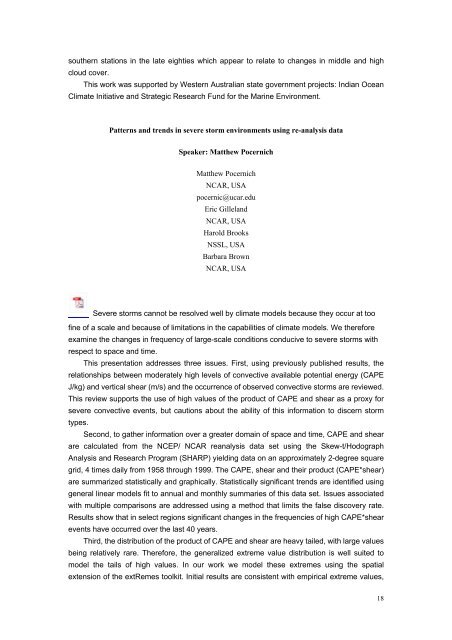The tenth IMSC, Beijing, China, 2007 - International Meetings on ...
The tenth IMSC, Beijing, China, 2007 - International Meetings on ...
The tenth IMSC, Beijing, China, 2007 - International Meetings on ...
You also want an ePaper? Increase the reach of your titles
YUMPU automatically turns print PDFs into web optimized ePapers that Google loves.
southern stati<strong>on</strong>s in the late eighties which appear to relate to changes in middle and high<br />
cloud cover.<br />
This work was supported by Western Australian state government projects: Indian Ocean<br />
Climate Initiative and Strategic Research Fund for the Marine Envir<strong>on</strong>ment.<br />
Patterns and trends in severe storm envir<strong>on</strong>ments using re-analysis data<br />
Speaker: Matthew Pocernich<br />
Matthew Pocernich<br />
NCAR, USA<br />
pocernic@ucar.edu<br />
Eric Gilleland<br />
NCAR, USA<br />
Harold Brooks<br />
NSSL, USA<br />
Barbara Brown<br />
NCAR, USA<br />
Severe storms cannot be resolved well by climate models because they occur at too<br />
fine of a scale and because of limitati<strong>on</strong>s in the capabilities of climate models. We therefore<br />
examine the changes in frequency of large-scale c<strong>on</strong>diti<strong>on</strong>s c<strong>on</strong>ducive to severe storms with<br />
respect to space and time.<br />
This presentati<strong>on</strong> addresses three issues. First, using previously published results, the<br />
relati<strong>on</strong>ships between moderately high levels of c<strong>on</strong>vective available potential energy (CAPE<br />
J/kg) and vertical shear (m/s) and the occurrence of observed c<strong>on</strong>vective storms are reviewed.<br />
This review supports the use of high values of the product of CAPE and shear as a proxy for<br />
severe c<strong>on</strong>vective events, but cauti<strong>on</strong>s about the ability of this informati<strong>on</strong> to discern storm<br />
types.<br />
Sec<strong>on</strong>d, to gather informati<strong>on</strong> over a greater domain of space and time, CAPE and shear<br />
are calculated from the NCEP/ NCAR reanalysis data set using the Skew-t/Hodograph<br />
Analysis and Research Program (SHARP) yielding data <strong>on</strong> an approximately 2-degree square<br />
grid, 4 times daily from 1958 through 1999. <str<strong>on</strong>g>The</str<strong>on</strong>g> CAPE, shear and their product (CAPE*shear)<br />
are summarized statistically and graphically. Statistically significant trends are identified using<br />
general linear models fit to annual and m<strong>on</strong>thly summaries of this data set. Issues associated<br />
with multiple comparis<strong>on</strong>s are addressed using a method that limits the false discovery rate.<br />
Results show that in select regi<strong>on</strong>s significant changes in the frequencies of high CAPE*shear<br />
events have occurred over the last 40 years.<br />
Third, the distributi<strong>on</strong> of the product of CAPE and shear are heavy tailed, with large values<br />
being relatively rare. <str<strong>on</strong>g>The</str<strong>on</strong>g>refore, the generalized extreme value distributi<strong>on</strong> is well suited to<br />
model the tails of high values. In our work we model these extremes using the spatial<br />
extensi<strong>on</strong> of the extRemes toolkit. Initial results are c<strong>on</strong>sistent with empirical extreme values,<br />
18






![final_program_abstracts[1]](https://img.yumpu.com/19102520/1/174x260/final-program-abstracts1.jpg?quality=85)









